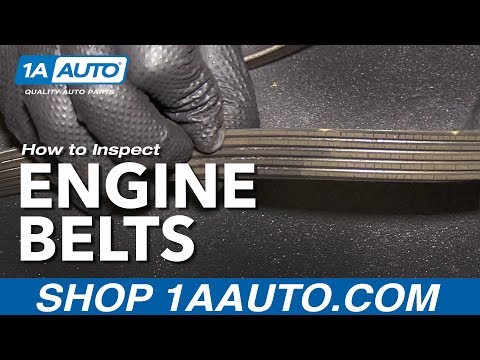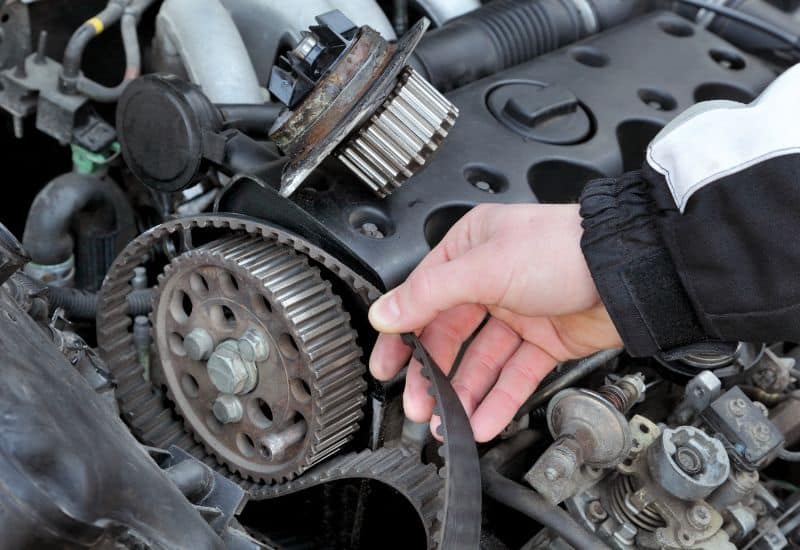
As the name implies, your car’s serpentine belt snakes around your engine bay, engaging a wide range of pulleys. It transfers some of the engine’s motion to power critical components like the alternator, water pump, air conditioning system, and power steering pump.
Bad serpentine belt signs often start out with screeching noises under the hood when you start the car and sometimes when you accelerate. They can quickly worsen into problems with weak charging from the alternator, a struggling power steering system, and more.
To find out if you’re truly experiencing bad serpentine belt signs or if there’s some other fault at play, we will have to take a few twists and turns through some technical details.
Symptoms of a Bad or Failing Serpentine/Drive Belt
The earliest symptoms of a bad serpentine belt tend to be a screeching or high-pitched whining sound at start-up. Though this isn’t always the case, and sometimes a screech on its own can be a sign of a different problem.
1. Screeching Sounds at Startup or When Accelerating

Screeching sounds when starting the engine or accelerating hard is one of the most common and obvious bad serpentine belt signs. This is usually due to the worn teeth on the underside of the belt slipping along the pulleys as the engine cycles rapidly.
Though a screeching serpentine belt on its own isn’t a complete confirmation that the belt is bad, if you’ve recently had a coolant leak in the engine bay or even accidentally got a drop of oil from the dipstick on one of the pulleys, it could cause the belt to slip. This could cause a similar screeching noise, yet the belt itself might be perfectly fine.
2. The belt Shows Signs of Fraying, Cracking, or Splitting
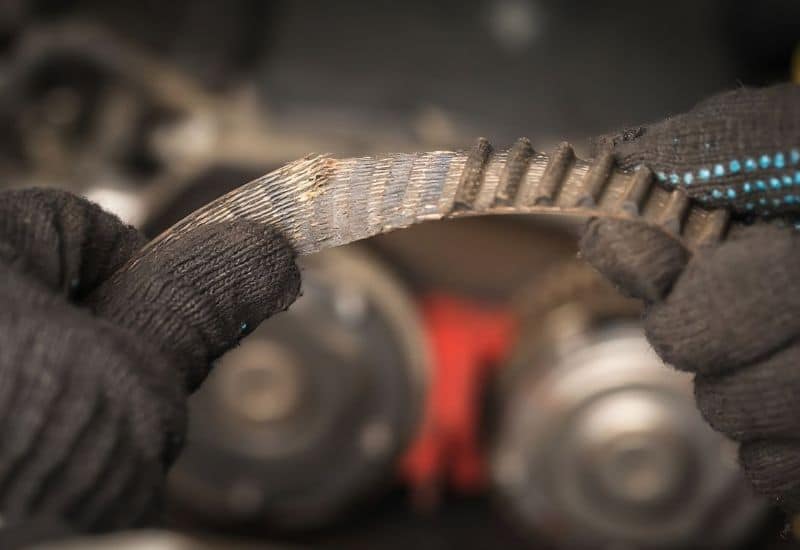
One of the more sure bad serpentine belt signs is fraying, cracking, or even splitting on the belt itself. As the belt degrades naturally over time, the structural integrity can cause it to come apart gradually. This is a natural effect of simple wear and tear, which can start to occur after 50,000 miles or more.
If the belt is relatively new, say within a year or two. Still, it’s showing signs of fraying, cracking, or splitting; the underlying problem might be with the tensioner pulley or an alignment issue with one of the other pulleys. If you don’t correct this issue, replacing the bad serpentine belt will ultimately be a short-term fix.
3. Engine Components Perform Poorly

Another bad serpentine belt sign to be aware of is the poor performance of certain engine components. This might manifest as an alternator that charges poorly yet tests as being good, or perhaps your power steering feels weak, yet the power steering reservoir is full. Even weak air conditioning could be a bad serpentine belt sign.
These components draw their power from the serpentine belt to perform normally. If the belt tensioner is too loose, or you have a bad serpentine belt, then multiple components will have performance issues.
If you have one belt-driven component that’s underperforming, it might be an alignment issue with the pulley itself. This can damage the belt causing fraying and cracking while also causing the component to underperform. You’ll then need to address the pulley alignment issue and replace the bad serpentine belt.
4. Engine Overheating
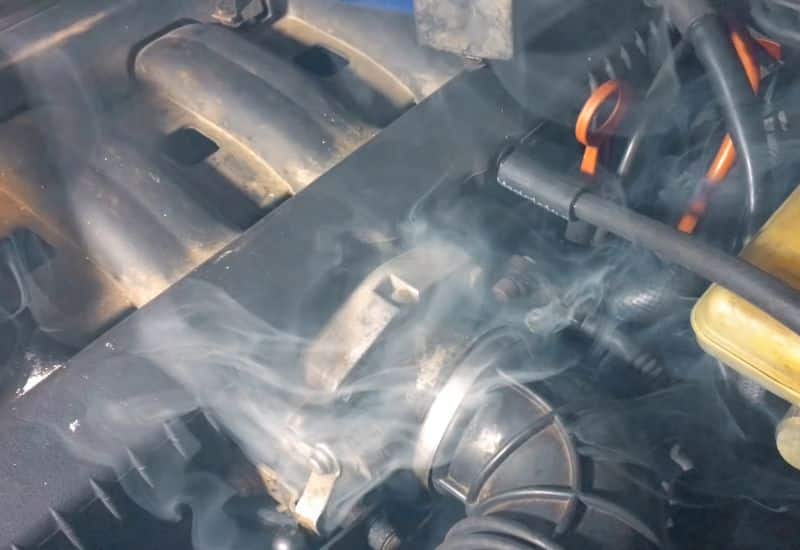
Overheating due to an underpowered water pump is another common bad serpentine belt sign. When coolant isn’t allowed to circulate properly it can’t carry heat away from the engine block.
This usually starts with the car running a little hot, which you might not notice on a short drive. However, longer drives or being stuck in stop-and-go traffic can cause the car to run from running hot to suddenly overheating.
Of course, the bigger concern here is that anytime the engine overheats from a bad serpentine belt, affecting the water pump, it can also cause serious engine damage.
5. Engine Stalling

Seemingly unexplained engine stalling is one of the more pronounced bad serpentine belt signs. This is usually due to a badly degraded belt failing to power the alternator, which causes the battery to run flat and kills the engine.
6. Check the Engine Light
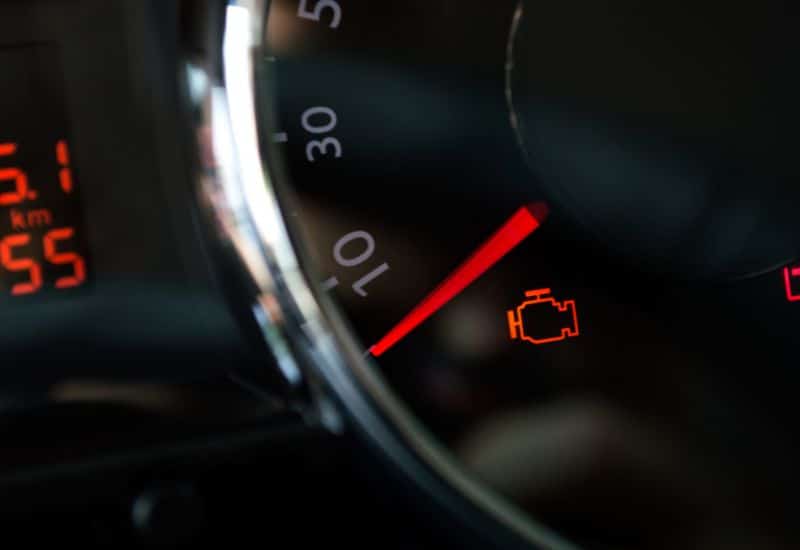
Blips and hiccups in power caused by a bad serpentine belt can cause the ECU to turn on the check engine light. Though there isn’t a specific code for the serpentine belt. When the check engine light often comes on, the belt severely compromises other engine components or is completely broken.
What Does a Bad Serpentine Belt Sound Like?
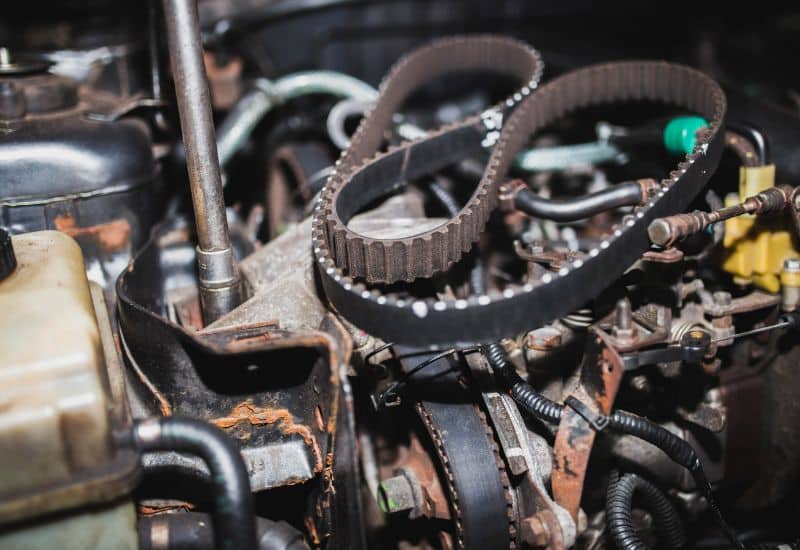
One of the most common bad serpentine belt signs is a high-pitched squealing noise when you first start the car. The screech might also start to happen when you accelerate hard; some would describe it as being one step under the sound of nails on a chalkboard. As the belt finally catches, the pitch of the screech usually goes up an octave until it vanishes.
As the serpentine belt worsens, you might also notice slapping or grinding noises. This is a sign that the belt itself is starting to degrade and/or isn’t properly connecting with all of its assigned pulleys.
What Happens If You Drive with a Bad Serpentine Belt?
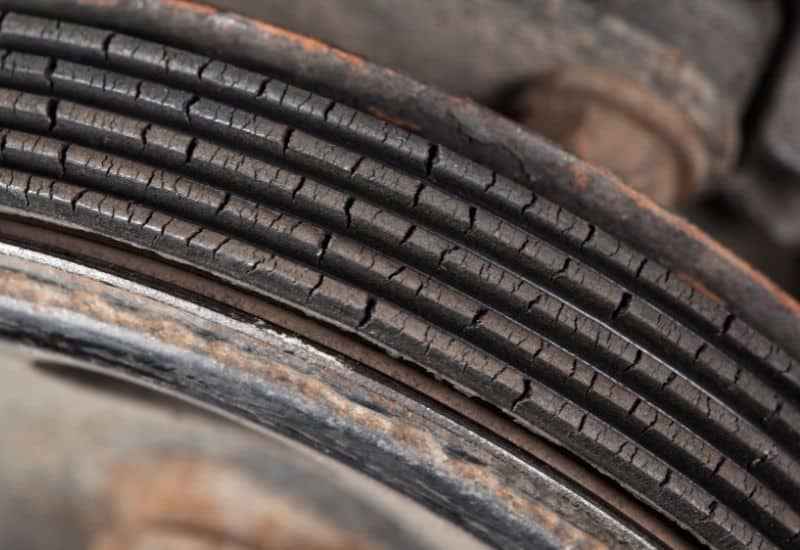
Early on, a bad serpentine belt won’t cause major issues with engine performance. Squealing and poor air conditioning performance won’t cause an immediate safety issue. If the car starts running hot or the battery indicator struggles to get up to the halfway mark, you risk damaging the car and/or leaving yourself stranded.
What is the lifespan of a serpentine belt?
The average lifespan of a serpentine belt can range from 50,000 to 100,000 miles. Though 65,000 to 75,000 is more realistic in the real world.
Remember that alignment issues with one or more belt-driven components, like the alternator or the power steering pump, can wear out a belt prematurely. An issue with the primary tensioner pulley can also lead to premature serpentine belt wear.
How Many Years Do Serpentine Belts Last?
The average serpentine belt lasts around 5 to 7 years. If you’re noticing bad serpentine belt signs earlier than 4 years or before 50,000 miles, it might be a problem with the tensioner pulley, or the pulley on one of the belt-driven engine components is out of alignment.
How Do You Test a Serpentine Belt?
If you’ve noticed bad serpentine belt signs, you can perform a layman’s test by pressing your finger down on the belt in the middle of its longest span between pulleys. A serpentine belt in good condition shouldn’t have more than half an inch of movement.
Testing a Bad Serpentine Belt with a Wear Gauge
Newer serpentine belts from EPDM (Ethylene Propylene Diene Monomer) don’t easily show signs of wear and tear like serpentine belts from reinforced rubber. Rather than looking for fraying and cracks, the best way to test or confirm if an EPDM serpentine belt is bad is to use a wear gauge and the following steps.
If it stays properly seated with little to no movement, your car’s EPDM serpentine belt itself is likely good. Though it probably means that the bad serpentine belt signs you’ve noticed are likely related to some other issue.
This is most likely a failing tensioner pulley or a belt-driven engine component with a misaligned pulley affecting the serpentine belt’s performance.
If the belt gauge rocks back and forth excessively, slides laterally, or lays completely flush against your EPDM serpentine belt, it likely means the belt’s material has degraded to the point that it needs to be replaced.
Though if the belt has less than 50,000 miles on you, you should strongly suspect that one or more pulleys in the engine components or the tensioner arm are the true underlying cause of the bad serpentine belt signs.
How Much Does It Cost to Replace a Serpentine Belt?
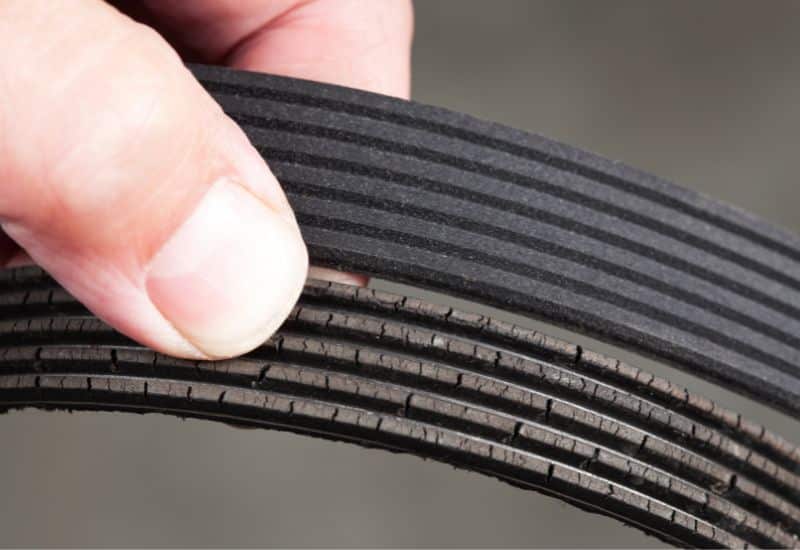
The cost to have a mechanic replace your serpentine belt ranges from $55 to $150. Though if you’re a modestly capable DIY mechanic, you should be able to find the replacement serpentine belt for less than $100, and you should be able to replace it yourself in less than an hour.
If you’re up for the task, you can find a matching serpentine belt at most auto parts stores. Then you can replace it via the following steps.
If you find a bent, worn, discolored, or damaged pulley, you’ll have to deal fix it separately before you can fit the new serpentine belt. Otherwise, it will just damage the new belt in short order.
Frequently Asked Questions
Can a Broken Serpentine Belt Ruin an Engine?
A completely broken or severed serpentine belt won’t be able to power the water pump or any of the engine’s cooling systems, which can cause damage by overheating or cause other engine performance issues.
Not only can overheating foul spark plugs and shut the engine down. It can also cause the head gasket to fail, the cylinder head can crack, and increase the risk of damaging the valves. These are all just some of the potential damage that can occur to an engine when you try driving with a broken serpentine belt.
The car might run for a little while. Though the alternator also won’t be able to charge the battery, the engine block’s heat will climb steadily. Either one of these issues will cause the car to stop running in roughly half an hour or less.
Can a Worn-Out Serpentine Belt Damage an Engine?
A worn-out serpentine belt can also cause damage to engine components. As the alternator, water pump, power steering system, and other components struggle to perform due to a loose or slipping serpentine belt, the components themselves or internal brushings can start to wear out at an accelerated rate.
At the same time, an engine with a bad serpentine belt will also see performance issues in the water pump, affecting the cooling system. This can start out as an engine that runs a little hot or a battery that never quite has sufficient charge.
The longer you drive with a worn-out serpentine belt, the more likely the engine is to overheat. At the same time, a lead-acid battery that is routinely drained to below 50% can also suffer internal damage to the battery components shortening its life.
It’s also worth bearing in mind that the underpowered power steering system due to a bad serpentine belt will also place additional strain on some of the car’s steering components. Given enough time, these stresses could also damage the power steering system.
Conclusion
Bad serpentine belt signs can sometimes start out subtle such as a squealing noise at startup, power steering that feels a little stiff, and in-cab air conditioning that isn’t quite up to snuff. Though these bad serpentine belt signs usually mean the belt is slipping or running loose, leading to underpowered engine components.
In time a bad serpentine belt can cause the alternator to underperform, leading to a low or flat battery. Not to mention the serious implications of an underperforming water pump affecting the engine’s cooling system.
Traditional serpentine belts made from reinforced rubber will typically show signs of fraying, cracking, and splitting. You can usually press on the longest stretch of the belt, and if it deforms by more than half an inch, the bad serpentine belt needs to be replaced.
If you have a newer serpentine belt made from EPDM, the visual signs of wear will not be as obvious. You’ll need to test it with a belt wear gauge, usually found at most auto parts stores. Replacing a bad serpentine belt is usually within what a DIY mechanic can handle.
Though if your serpentine belt has been through less than 50,000 miles, you should strongly suspect there is an issue with your engine’s tensioner pulley and/or an alignment issue with one of the pulleys on a belt-driven component like the alternator, power steering pump, water pump or air conditioning compressor.

Written By
Jason Farrell
Jason Farrell is a certified master technician, the editor of Mechanic’s Diary in Pittsburgh, Pennsylvania. He is ASE (Automotive Service Excellence) certified and earned a Bachelor’s Degree in Automotive Technology from Pittsburg State University. With nearly 18 prior years of experience in the automotive field, he has extensive knowledge about Domestic, European, and other foreign makes and models of cars and light trucks. Jason’s experience working as a technician and service manager at dealerships, gave him the experience and know-how of most aspects of inspection, diagnosis, and repair from engine and drivability to electrical, HVAC, brakes, steering and suspension and everything in between.

